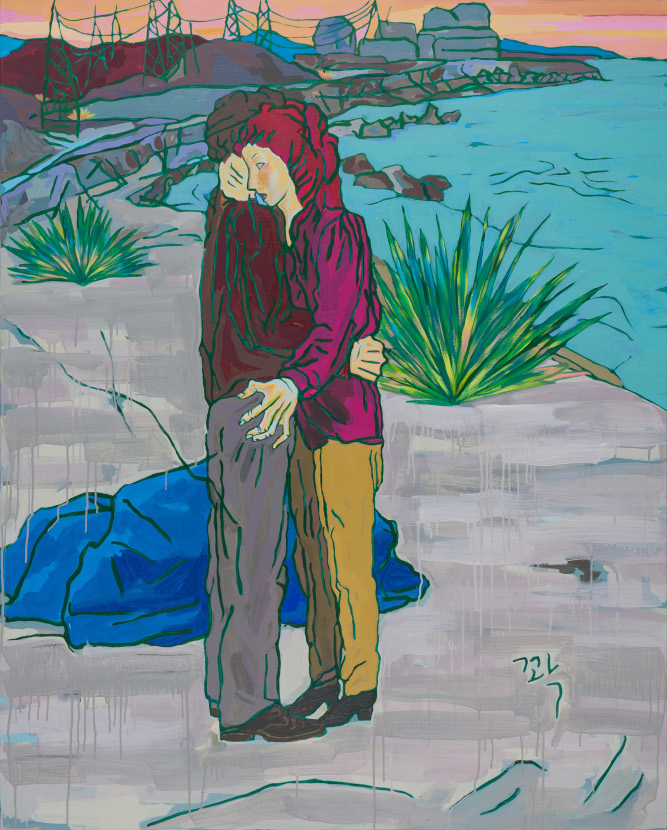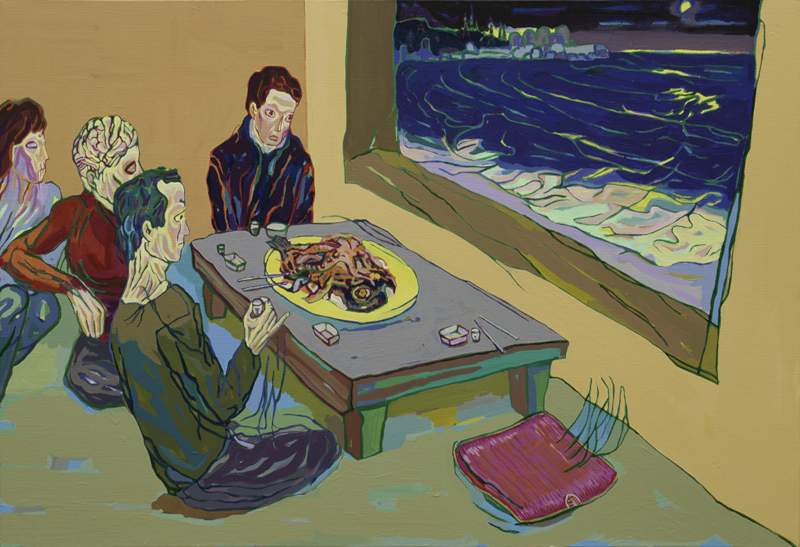バン・ジョンア BANG Jeong A

《彼女が手を挙げた瞬間》2019年 アクリル、カンヴァス 90×140cm
Moment When She Raised Her Hand, 2019, Acrylic on canvas, 90×140cm
バン・ジョンア
BANG Jeong A
1968年、韓国・釜山生まれ。同地に在住、活動。
以下は、2019年の釜山市立美術館開催の《韓国現代美術家に注目する1-信じられないほど重く、とてつもなく微細な:バン・ジョンア展》のテキスト序文からの抜粋である。
パク・ジンヒ(釜山市立美術館キュレーター)
バン・ジョンアの作品世界の出発点
バン・ジョンアの芸術について記述する前に、まずは彼女の活動のスタート時点を韓国の現代美術史の中に位置づけておきたい。バンが大学入学(1987)と共に経験した1980年代の韓国美術は、二つの相反する流派によって特徴付けられる。一つは、フォーマリストの抽象絵画、もう一つは民衆美術だ。後者は反モダニズム運動であり、フォーマリスト抽象絵画の政治的な権力に対して反対するものであった。1980年代美術の主流傾向のひとつになった民衆美術は、保守化し権威となったモダニズム芸術に対する抵抗だった。それは社会の不条理を批判する認識論的な運動を意味し、軍事政権下における韓国の政治的な特殊性に深く関わる役割を果たした。バンは大学在学中民衆美術に関心を持ち、その活動に加わることで、芸術活動の根底となる現実への認識と芸術家としての使命感を備えることになったと思われる。このことは、今日に至るまで彼女の作品がもつ現実的感覚を維持し続ける起動力になっている。(中略)
彼女の関心はその後、自然、エコロジー、そして自らの生きる社会へと広がっていき、作品世界はさらなる広がりを見せた。拡張された世界は、現実に基づいた作家の身の回りの風景として現れる一方で、超現実的な世界としても現れた。すなわち、作家が造形的なイメージから成る風景を解体し、自身の無意識と融合させながら抽象的イメージへと変換させたもののようにも見えた。 2018年の光州ビエンナーレでは、原発反対デモに集まった人々、そして「キャンドルデモ」に参加した人々のイメージを提示した。同年の個展「波打ち、揺れ動くところ」では、(朝鮮半島の)南北分断から勃発する戦争への恐怖と、それが引き起こす身体的な兆候を表現した。このように、バン・ジョンアの作品は、その内容や造形という点では、常に変化してきた。それとともに彼女は、社会問題について常に現場に身を置きながら考えるという点では首尾一貫していたのである。(中略)
上に述べたバン・ジョンアの作品の特徴全般を振り返ると、以下のようにまとめられるだろう。彼女の作品は「今、ここで、捉えられたもの」、「固定されることなく揺れ動くこと」であり、「世界に対して絶えず問いを投げかけている」のだと。バン・ジョンアの作品は数え切れない寓意を生み出しながら、彼女の温かいメッセージは曖昧なものではないが、比喩的なものとして鑑賞者に届けられる。それにもかかわらず、バン・ジョンアの芸術はリアリズム画家としての確固たる基盤に根ざしている。つまり彼女が提示する、人類に対する人間的な視点に基づく生命観、そして、今ここにある生命の意味についての柔軟な解釈を通じて得られる社会への鋭い意識が、バン・ジョンアの芸術を支える基盤である。
監訳:金惠信 英文和訳:宮川緑
Born in 1968, Busan, Korea. Lives and works in Busan.
The following is the lighting of Korean contemporary artists at the Busan Museum of Art in 2019.
– Unbelievably heavy and Awfully Keen/ is a quote from some of the preface of Bang Jeong A.
Park Jinhee, curator, Busan Museum of Art
Starting Point of Bang Jeong-A’s Art
Before jumping into discussion of Bang Jeong-A’s art, I would like locate where her practice occupies within the development of Korean contemporary art.
The Korean art of the 1980s that she experienced during academic years was characterized with two opposing camps; one is the formalist abstract painting and the other is Minjung Art, the anti-Modernist movement that opposed to the political empowerment of formalist abstract painting.02 Minjung Art in the late 1980s was a resistance against the Modernist practices that became more conservative and authoritative power. It meant a sort of epistemological movement that criticized absurdities in the society and performed politically engaged in Korea’s political specificity under the military regime. During the university period, Bang took interest and participated in Minjung Art activities. This in return became the period during which she consolidated awareness of the artist’s social role and sense of reality that would feed her art practice. This gave her impetus for her keeping her sense of reality in her art that continues till today.
Her interest then extended toward nature, ecology, and the society making her to create extended worlds. These extended worlds appeared as landscapes of her own surroundings based on reality on one hand, and appeared as surreal world, or as landscapes with figurative images that she de-constructed then transformed into abstract image by combining with her subconscious on the other. In the 2018 Gwangju Biennale, she submitted image with people who assembled demonstrating against nuclear issues and people from Candle Assemply. In her 2018 solo exhibition, <Where It Heaves And Churns>, she expressed fear of war caused by the division of the country and its physical symptoms.
Like this, Bang Jeong-A’s art was always in flux in terms of its contents and forms. It also has been always consistent that she is aware of social issues while being afloat in them.
If we look back all the aspects of Bang Jeong-A’s art mentioned above, it can be summed up they are ‘things captured here, now,’ ‘things continue without being fixed,’ and ‘constantly raising questions toward the world.’ Art of Bang Jeong-A creates numerous allegories while her warm messages are delivered metaphorically if not ambiguous. Nonetheless, Bang Jeong-A’s art stems from the firm ground as Realism painter in the sense that she suggests visions on life from humane perspectives toward mankind and keen awareness of the society through flexible perception on the meanings of life as here, and now.
방정아 1968 한국 부산 출생
거주지 부산, 활동지역 부산 및 한국 내외.
다음은 2019 부산시립미술관 한국현대미술작가조명1
-믿을 수 없이 무겁고 엄청나게 미세한/방정아 전 전시 서문 중 일부를 인용한 것이다.
박진희(부산시립미술관 학예연구사)
방정아 작업세계_시작점
방정아 작품세계를 논하기에 앞서 한국 현대미술사 흐름 속 방정아의 활동 시작점에 대해 짚어보고자 한다. 그녀가 미술대학에 입학(1987년)하여 경험한 1980년대 한국미술은 형식화된 추상미술, 미술제도의 권력화를 비판하는 반모더니즘 양상02이 특징이었다.
1980년대 주류 양상이 되었던 민중미술 운동은 권력화·보수화한 모더니즘에 대한 항거였다. 이는 한국의 군사정부라는 정치 현실 속에서 사회적 부정을 비판하고 정치적 참여예술을 수행하는 일종의 인식론적 운동이었다고 평가된다. 작가는 미술대학 시절 민중미술의 활동을 주목·참여하였고, 예술 활동의 뿌리가 되는 현실 인식, 예술가 역할에 대한 사명의식이 다져진 시기였다고 본다. 현재까지 이어지는 작업 행보와 태도, 지속적으로 현실 인식에 대한 끈을 놓치지 않는 이유를 여기에 두고자 한다.
자연·생태·사회로의 확장된 시선은 확장된 세계를 만들어내기 시작하였고 그 세계는 현실에 기반한 주변의 모습으로, 때로는 초현실적 세계로, 때로는 형상 이미지를 해체하여 추상적 이미지로 무의식과 결합하는 모습으로 나타난다. 2018년 광주비엔날레에서는 원전 문제와 촛불집회의 군중의 모습을 등장시켰다. 2018년 개인전 《출렁거리는 곳》에서 작가가 밝힌 작업 내용은 “분단으로 인한 전쟁 공포와 이로 인한 신체적 증상”이었다.
이렇듯 방정아 작업의 내용과 방식은 끊임없이 유동적이며, 시대의 사건을 반영하고 있다. 사회 인식의 끈을 놓지 않는 태도는 계속 지속되고 있다고 본다.
앞서 밝힌 방정아의 작업 특징들과 태도를 종합해보면, ‘지금·여기서 포착되는 모든 것’, ‘고정되지 않으며 유동하기’, ‘지속적으로 세상에 던지는 문제들’로 볼 수 있다.작품의 세계는 따뜻하면서도 은유적으로 모호하게 전달되며 무수한 알레고리를 생성시킨다. 그럼에도 불구하고 방정아는 인간에 대한 휴머니즘적 관점, 냉철한 사회 인식과, 지금·여기의 삶의 의미를 유동적으로 인식하고 있다. 이를 통해 더 나은 삶에 대한 전망을 제시한다는 점은 기본적으로 리얼리즘 작가로서의 성격을 확보하고 있다.
更新された最新の情報は、作家のウェブサイトをご覧ください。
Please refer to the artist’s website for new updates.
http://www.bjart.net/page_SxPU72

《クァッㇰ》2017年 アクリル、カンヴァス 162.2×130.3cm
Ggwack, 2017, Acrylic on canvas, 162.2×130.3cm
*クァッㇰ:強く握る様子の’キュッと’という意味の擬態語
 《ヘッㇰ(核)ヘッㇰ 》 2016年 アクリル、カンヴァス 72.7×116.8cm
《ヘッㇰ(核)ヘッㇰ 》 2016年 アクリル、カンヴァス 72.7×116.8cm
Hackheck, 2016, Acrylic on canvas, 72.7×116.8cm

《慌ただしい入浴》1994年 アクリル、カンヴァス 45.5×97cm
A Rushing Bath, 1994, Acrylic on canvas, 45.5×97cm

